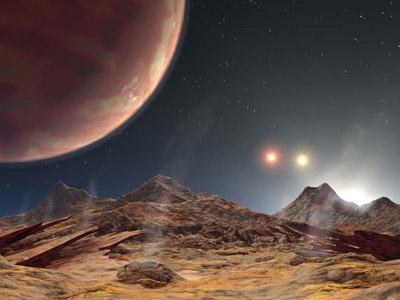
This artist's concept of HD 1885 Ab, the first known planet to reside in a triple-star system, would have a similar sunset to KELT-4Ab. Both systems host a pair of stars distantly orbiting the planet-hosting single sun.
Eat your heart out, Tatooine: A newly discovered alien planet has not one, not two, but three suns in its sky.
While scientists know of many planets with two suns, a planet with three bright stars in its sky is much rarer. The newly found distant world, known as KELT-4Ab, orbits one star. That star in turn is orbited by a nearby pair of stars. The twin stars are close enough to the planet to appear about as bright as the full moon in the sky, new research has revealed.
In addition to providing an example of a solar system very different from Earth's, the strange arrangement may help provide insight into how gas giants that lie close to their parent star — known as "hot Jupiters" — evolve.
A Triple Sunset
KELT-4Ab, which is about as massive as Jupiter, orbits the single star KELT-A once every three days. Nearby, the stars KELT-B and KELT-C orbit one another once every 30 years, and together they travel around KELT-A and its planet every 4,000 years or so.
Jason Eastman, a research associate at the Harvard-Smithsonian Center for Astrophysics, is the lead author of a study that used the two robotic telescopes that make up the Kilodegree Extremely Little Telescope (KELT), located in Arizona and South Africa respectively, to identify the system that includes the single star KELT-A, the more distant pairing KELT-BC and the overheated planet.
While the composition of the planet's atmosphere isn't yet known, Eastman told Space.com that standing in the atmosphere above the planet (since you can't stand on its surface), the single star would appear to be about 40 times as large as the sun appears in the sky on Earth. Each member of the binary star pair would be almost as bright as the full moon, though without a good telescope they would look like dots of light about a pinky-finger-width apart in the sky.
"Those two stars would orbit each other every about 30 years, and every 4,000 years they'd make one orbit around KELT-4A," Eastman said.
Read more on Space.com...
Projects
AbacusSummit
AstroAI
GMACS
For Scientists